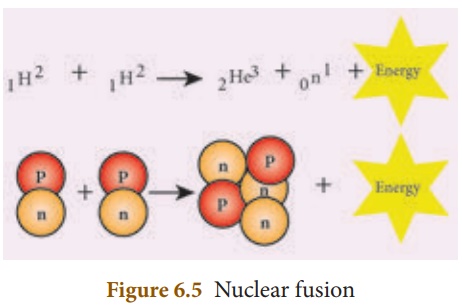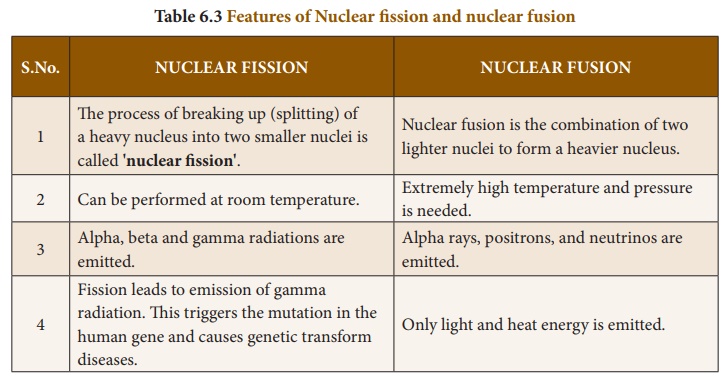Definition, Conditions necessary, Stellar Energy - Nuclear Fusion | 10th Science : Chapter 6 : Nuclear Physics
Chapter: 10th Science : Chapter 6 : Nuclear Physics
Nuclear Fusion
NUCLEAR FUSION
You have learnt that
energy can be produced when a heavy nucleus is split up into two smaller
nuclei. Similarly, energy can be produced when two ighter nuclei combine to
form a heavier nucleus. This phenomenon is known as nuclear fusion.
1. Definition
The process in which two
lighter nuclei combine to form a heavier nucleus is termed as 'nuclear fusion'.
E.g.: 1H2
+ 1H2 → 2He4
+ Q (Energy)
Here, 1H2
represents an isotope of hydrogen known as 'deuterium'. The average energy
released in each fusion reaction is about 3.84 × 10-12 J. Figure 6.5
represents this.

The mass of the daughter
nucleus formed during a nuclear reaction (fission and fusion) is lesser than
the sum of the masses of the two parent nuclei. This difference in mass is
called mass defect. This mass is converted into energy, according to the
mass-energy equivalence. This concept of mass-energy equivalence was proposed
by Einstein in 1905. It stated that mass can be converted into energy and vice
versa. The relation between mass and energy proposed by Einstein is E = mc2
where c is the velocity of light in vacuum and is equal to 3 × 108
ms–1.
2. Conditions necessary for nuclear fusion
Earth’s atmosphere
contains a small trace of hydrogen. If nuclear fusion is a spontaneous process
at normal temperature and pressure, then a number of fusion processes would
happen in the atmosphere which may lead to explosions. But, we do not encounter
any such explosions. Can you explain why?
The answer is that
nuclear fusion can take place only under certain conditions.
Nuclear fusion is
possible only at an extremly high temperature of the order of 107 to
109 K and a high pressure to push the hydrogen nuclei closer to fuse
with each other. Hence, it is named as 'Thermonuclear reaction'.
3. Stellar Energy
The stars like our Sun
emit a large amount of energy in the form of light and heat. This energy is
termed as the stellar energy. Where does this high energy come from? All stars
contain a large amount of hydrogen. The surface temperature of the stars is
very high which is sufficient to induce fusion of the hydrogen nuclei.
Fusion reaction that
takes place in the cores of the Sun and other stars results in an enormous
amount of energy, which is called as 'stellar energy. Thus, nuclear fusion or
thermonuclear reaction is the source of light and heat energy in the Sun and
other stars.
4. Hydrogen Bomb
Hydrogen bomb is based
on the principle of nuclear fusion. A hydrogen bomb is always designed to have
an inbuilt atom bomb which creates the high temperature and pressure required
for fusion when it explodes. Then, fusion takes place in the hydrogen core and
leads to the release of a very large amount of energy in an uncontrolled
manner. The energy released in a hydrogen bomb (or fusion bomb) is much higher
than that released in an atom bomb (or fission bomb).
Features of Nuclear fission and nuclear fusion
NUCLEAR FISSION
1. The process of breaking up
(splitting) of a heavy nucleus into two smaller nuclei is called 'nuclear
fission'.
2. Can be performed at room
temperature.
3. Alpha, beta and gamma radiations
are emitted.
4. Fission leads to emission of
gamma radiation. This triggers the mutation in the human gene and causes
genetic transform diseases.
NUCLEAR FUSION
1. Nuclear fusion is the combination
of two lighter nuclei to form a heavier nucleus.
2. Extremely high temperature and
pressure is needed.
3. Alpha rays, positrons, and
neutrinos are emitted.
4. Only light and heat energy is
emitted.

Related Topics